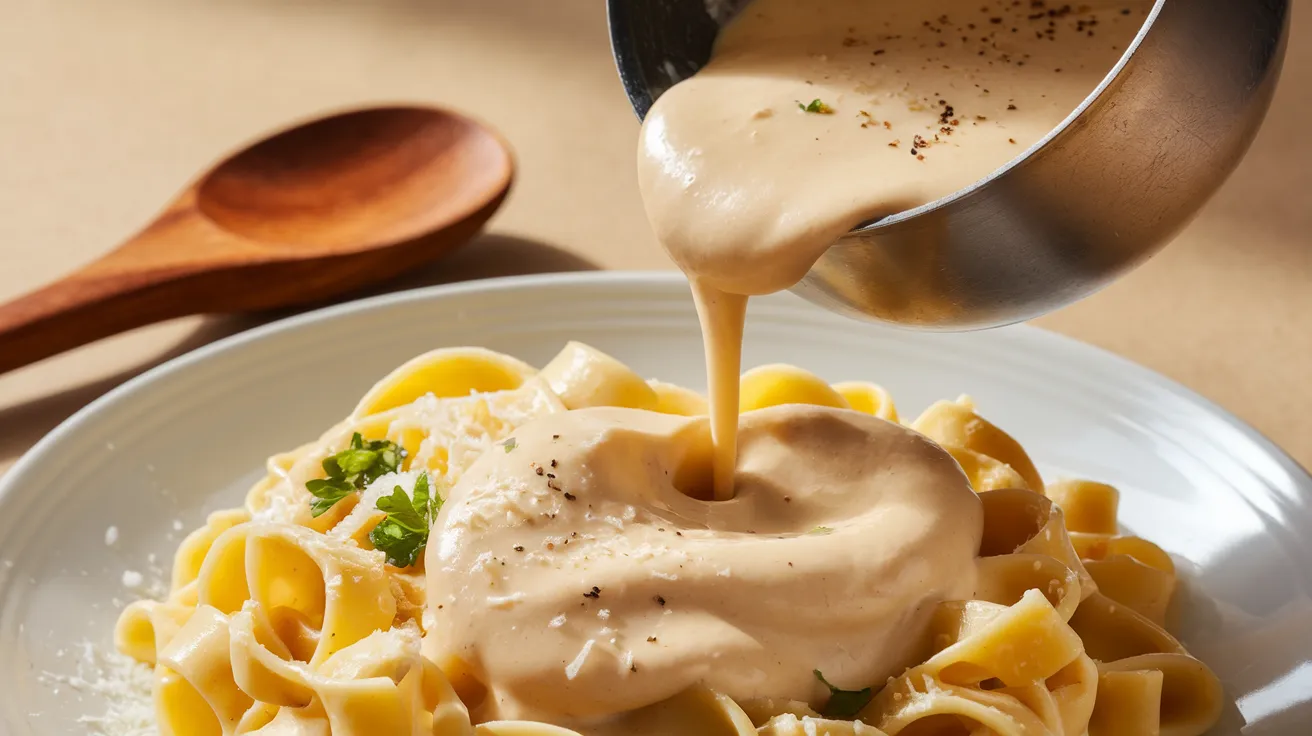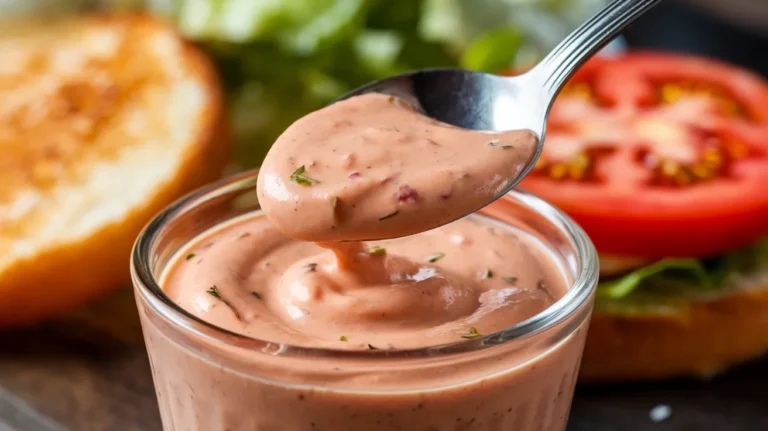Prep Time: 5 minutes | Cook Time: 10 minutes | Total Time: 15 minutes | Serves: 4
Key Takeaways
- This creamy Alfredo sauce uses just 5 simple ingredients
- Ready in only 15 minutes from start to finish
- Costs 70% less than restaurant versions
- Perfect for fettuccine, chicken, or vegetable dishes
The Perfect Homemade Alfredo Sauce Recipe
You know that moment when you’re craving restaurant-quality Alfredo but don’t want to spend $20+ on pasta? I’ve been there too.
After testing dozens of recipes, I’ve created this foolproof homemade Alfredo sauce that’s rich, creamy, and unbelievably simple. This recipe serves four people generously and costs a fraction of restaurant prices.
This homemade Alfredo sauce recipe combines butter, fresh garlic, heavy cream, and Parmesan cheese to create a silky sauce that clings perfectly to pasta. As one of the essential base sauces in cooking, mastering Alfredo opens up countless dinner possibilities. Best of all? It’s ready in just 15 minutes.
Nutrition Comparison
| Nutrition (per serving) | Homemade Alfredo | Store-Bought | Restaurant |
|---|---|---|---|
| Calories | 320 | 390 | 480 |
| Fat | 32g | 35g | 45g |
| Sodium | 460mg | 820mg | 950mg |
| Carbs | 3g | 8g | 12g |
| Protein | 9g | 7g | 8g |
| Cost | $1.75 | $2.50 | $6.00 |
Equipment & Ingredients
Ingredients
| Ingredient | Amount | Notes |
|---|---|---|
| Unsalted butter | 4 tablespoons (½ stick) | European-style preferred |
| Fresh garlic | 2 cloves, minced | About 2 teaspoons |
| Heavy cream | 1 cup | Room temperature works best |
| Parmesan cheese | 1½ cups | Freshly grated, not pre-shredded |
| Salt | ¼ teaspoon | Plus more to taste |
| Black pepper | ¼ teaspoon | Freshly ground |
| Nutmeg (optional) | Pinch | Freshly grated if possible |
Kitchen Tools
| Tool | Purpose |
|---|---|
| Medium saucepan | For cooking the sauce |
| Wooden spoon | For stirring without scratching your pan |
| Microplane/grater | For grating Parmesan and optional nutmeg |
| Measuring cups/spoons | For accurate measurements |
| Whisk | For ensuring a smooth, lump-free sauce |
Substitutions
- Heavy Cream: Half-and-half can work in a pinch (sauce will be thinner)
- Parmesan: Pecorino Romano or Grana Padano can substitute
- Butter: Ghee works well; olive oil changes flavor but is possible
- Garlic: ½ teaspoon garlic powder if fresh isn’t available
Step-by-Step Instructions
Preparation Phase
- Take out ingredients and let them come to room temperature (15 minutes before cooking)
- Remove butter from refrigerator and cut into 4 equal pieces
- Measure 1 cup of heavy cream and let it sit on counter
- This step is important because cold ingredients can make your sauce separate
- Prepare the Parmesan cheese
- Take out a block of Parmesan (about 6-8 ounces)
- Using the fine side of your grater or a microplane, grate enough to make 1½ cups
- Place grated cheese in a bowl and set aside
- Beginner tip: Pre-grated cheese often contains anti-caking agents that can make your sauce grainy
- Prepare the garlic
- Peel 2 cloves of garlic
- Place flat side of knife on garlic and press firmly to crush slightly
- Finely mince the garlic into tiny pieces (about the size of grains of sand)
- Visual cue: The pieces should be so small they almost form a paste
- Set aside on cutting board
- Set up your cooking station
- Place medium saucepan on stove (don’t turn heat on yet)
- Arrange all ingredients within arm’s reach
- Have measuring spoons, wooden spoon, and whisk readily available
- Keep a clean spoon nearby for tasting
Cooking Phase
- Begin the sauce base
- Turn heat to medium (not medium-high or medium-low, just medium)
- Add the 4 tablespoons of butter to pan
- Wait until butter is about 80% melted (about 1 minute)
- Visual cue: You’ll see most of the butter has melted but small pieces remain
- Beginner warning: Don’t walk away during this step; butter can burn quickly
- Add and cook the garlic (the aromatic foundation)
- Add minced garlic to the melted butter
- Using wooden spoon, stir continuously for exactly 45-60 seconds
- Visual cue: Garlic should become fragrant and slightly translucent
- Important: Keep garlic moving constantly to prevent browning
- Sensory check: You should smell a warm, garlicky aroma, not a bitter or burned smell
- Incorporate the heavy cream
- While still stirring, slowly pour in 1 cup of heavy cream
- Pour in a steady stream while whisking gently to combine with butter-garlic mixture
- Visual cue: Mixture should look like a uniform, pale yellow liquid
- Increase heat slightly, just until tiny bubbles form around the edges (about 2 minutes)
- Beginner tip: These are not rolling boils, just small bubbles signaling it’s hot enough
- Monitor the initial simmer
- When you see small bubbles around the edge, reduce heat to medium-low
- Let mixture simmer gently for 3 minutes, stirring occasionally (about every 30 seconds)
- Visual cue: Sauce should coat the back of your wooden spoon
- Testing trick: Run your finger through sauce on back of spoon – it should leave a clean line
- Troubleshooting: If bubbles are large or sauce boils rapidly, immediately reduce heat
- Begin adding cheese (the critical step)
- Reduce heat to low (this is crucial for smooth incorporation)
- Add just ⅓ of your grated Parmesan (about ½ cup)
- Whisk continuously until completely melted (about 1 minute)
- Visual cue: No visible cheese pieces should remain before adding more
- Beginner warning: Adding all cheese at once will create clumps
- Continue adding cheese in stages
- Add second ⅓ of Parmesan
- Whisk until completely incorporated (about 1 minute)
- Add final ⅓ of cheese
- Whisk continuously until sauce is completely smooth
- Troubleshooting: If cheese clumps, remove from heat, add 1 tablespoon cream, and whisk vigorously
- Season the sauce
- Add ¼ teaspoon salt and ¼ teaspoon freshly ground black pepper
- If using, add just a tiny pinch of nutmeg (less than ⅛ teaspoon)
- Stir to combine seasonings evenly
- Tasting check: Carefully taste a small amount on clean spoon
- Seasoning tip: Parmesan is salty, so add additional salt sparingly
- Final consistency check
- Turn off heat
- Sauce should be thick enough to coat the back of a spoon but still pourable
- Visual test: When you stir, sauce should leave a trail that slowly disappears
- Consistency guide: Should be like warm honey, not as thick as pudding or as thin as milk
- If too thick: Add 1 tablespoon warm water or cream
- If too thin: Return to low heat for 1-2 minutes, stirring constantly
Finishing and Serving
- Prepare for serving
- Have pasta ready (12 oz of fettuccine cooked al dente works best)
- If pasta isn’t ready yet, place a lid on sauce and keep on lowest possible heat setting
- Beginner tip: Stir occasionally if keeping warm; sauce will continue to thicken
- Combine with pasta
- If using pasta: Transfer cooked, drained pasta directly to sauce
- Reserve ¼ cup pasta cooking water before draining pasta
- Use tongs to gently toss pasta in sauce until every strand is coated (about 1 minute)
- Visual cue: All pasta should have a shiny, creamy coating
- Troubleshooting: If sauce becomes too thick when tossing, add reserved pasta water 1 tablespoon at a time
- Serve immediately
- Transfer to warmed serving plates or bowl
- Garnish with extra grated Parmesan and freshly ground black pepper if desired
- Timing tip: Alfredo sauce waits for no one – serve right away for best texture and flavor

Troubleshooting
| Problem | Cause | Solution |
|---|---|---|
| Grainy sauce | Cheese added too quickly or heat too high | Remove from heat, add splash of cream, whisk vigorously |
| Too thin | Not simmered long enough | Continue simmering on low heat until desired thickness |
| Too thick | Simmered too long | Add small amounts of cream or pasta water until desired consistency |
| Garlic burned | Heat too high | Start over, as burned garlic can’t be fixed |
| Sauce separated | Heat too high or reheated improperly | Whisk in 1-2 tablespoons of heavy cream off heat |
| Bland flavor | Insufficient seasoning | Add pinch more salt, fresh grated Parmesan, or tiny bit of nutmeg |
| Cheese won’t melt | Cheese too cold or pre-grated | Remove from heat, let cheese come to room temp, whisk vigorously |
Variations & Substitutions
Ingredient Swaps
- Lighter version: Use half-and-half and reduce butter to 2 tablespoons
- Dairy-free: Not recommended for this classic recipe
- Extra flavor: Add 2 tablespoons cream cheese for tanginess
- Herb-infused: Add 1 teaspoon chopped fresh herbs like parsley, basil, or thyme
- Red sauce lover? Try my homemade marinara sauce recipe for a completely different but equally delicious pasta night
Popular Add-ins
- Grilled chicken breast (sliced)
- Sautéed mushrooms
- Steamed broccoli florets
- Cooked bacon or pancetta
- Roasted cherry tomatoes
- Fresh or frozen peas
Storage & Reheating
Storage Guidelines
- Refrigerator: Store in airtight container up to 3 days
- Freezer: Not recommended (sauce will separate)
Reheating Methods
- Stovetop (best method):
- Place in saucepan over low heat
- Add 1-2 tablespoons of cream
- Whisk constantly until warmed through
- Never boil when reheating
- Microwave (quick method):
- Heat in 30-second intervals at 50% power
- Stir between each interval
- Add splash of cream if needed
Safety Notes & Tips
Food Safety
- Sauce should reach 165°F to ensure safety
- Discard any sauce left at room temperature for more than 2 hours
- Always use freshly grated cheese for food safety and better melting
Pro Tips
- Pasta water secret: Reserve ¼ cup pasta cooking water before draining to thin sauce if needed
- Cheese tip: Buy a block of Parmesan and grate it yourself—pre-grated has anti-caking agents that prevent smooth melting
- Temperature matters: Room temperature cream helps prevent sauce from seizing
- One-pot method: For fewer dishes, you can toss cooked pasta directly into the sauce pan
Pairing Suggestions
- Wine: Chardonnay or Pinot Grigio
- Sides: Simple green salad with lemon vinaigrette, garlic bread
- Protein: Grilled chicken, shrimp, or salmon
Meta Description: Make restaurant-quality homemade Alfredo sauce in just 15 minutes using 5 simple ingredients. Creamy, rich, and perfect for pasta night!




